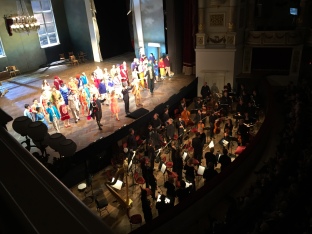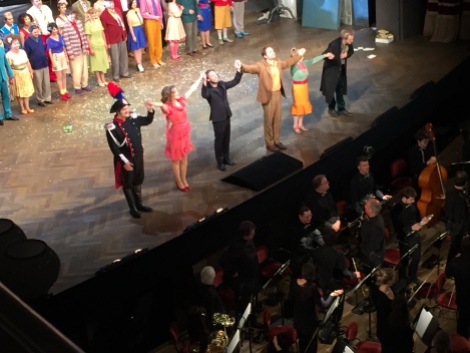After all the racy operas and design porn I’ve been posting, I’m not sure how to outdo myself and keep things clean. A trip to the Hygiene Museum in Dresden today, however, sent my senses to the cleaners. It seems that ditching the art world for science isn’t such a bad venture, at least for an afternoon.
I was enraptured with a series of well-presented exhibitions that included sex (well, sort of), the brain (neuroscience and scanning techniques), health, DNA, and lots of peripherals about the history of science education in the DDR and Germany. The Hygiene Museum was famous for the “first transparent man”, where you could see all the innerds reproduced through clear plastic. All of the above were a fascinating foray out of the world of art and architecture and into the other end of the spectrum.
While I consider myself decently informed on technology but low on science, this experiment in seeing how the other half of the world lives (into science and out of art) was pretty promising. I can truthfully thank the Dresden Hygiene Museum for this exposure. I have to confess that neither the Exploratorium nor the Lawrence Hall of Science in the Bay Area did it for me. My kids loved both, but my ADD never allowed me to concentrate on anything. I think that this visit has changed my perspective on science museums.
Other than a few NOVA episodes or a Long Form broadcast on how a tongue disease kept someone from from being able to speak (my daughter forced me to listen to the episode during our drive from Berlin to Amsterdam in January), I confess that I zone out on scientific explanations of the world.
Two seminal experiences on this trip have changed my attitude, thankfully. One was the Naturkundes Museum in Berlin (the Natural History Museum), where I finally learned how the earth’s crust functions, and today’s post, the Hygiene Museum. Maybe it’s the aura of being in Germany that has worked wonders on my appreciation of science. Whatever it is, it’s working!
The Hygiene Museum has a somewhat checkered history. I gathered that from the first introduction poster that tactfully explained how all subject matter was voluntary or approved to the extent possible. No knowing pain or agony was inflicted on the part of subjects used in research experiments. I took this as a moment of truth and trusted the claim, at least for now.
That having been said, the history of the museum itself featured prominently in displays. The museum either presented research from or collaborated with other institutions (like the Max Planck Institute or Deutsches History Museum in Berlin) to develop displays. I found these very curious as the information was apt to talk about its past, frank, and very unique from the way Americans would present information.
Here are a few examples:
Photos Above, top to bottom, left to right:
1. Display on Food and input from visitors on what they think should be done to improve healthy eating habits
2. Effect of MacDonalds on humanity and the iconic image of Ronald MacDonald
3. Overall Display
4. World Map of Life Expectancies in Selected Countries: Germany, US, Canada are high, but not the highest. Can you guess the country with the highest life expectancy? The lowest? Some of the statistics are surprising.
5. An explanation of PET technology: you can slide the red bar horizontally in each image to see the slices in the brain scans (if you’re like me, you always wanted to manipulate these images but never could do it unless you found a museum like this one).
Displays below are about childbirth and delivery:
1. top left: birthing chair, that was popular in the 19th century. It was portable and used by midwives who carried the chair to their patients, who delivered at home; or families owned a chair that was handed down within generations in the family. It was not until the latter half of the 20th C. that the prone position in hospitals became a more accepted way of delivery. The stool was used by the woman delivering as a counterbalance. Now, the chair is coming back, using gravity as the assistant to natural delivery. (ed. note: why didn’t I know this??)
2. video of a baby going through the birth canal (ed note: why didn’t I see this before??)
3. The different stages of a baby going through the birth canal as the cervix dilates (ed. note: why didn’t I know or see this before??? Do you know how many women have gone through this without a visual image of what happens??)
The displays below will not format into a gallery for some reason. Perhaps it’s just as well. See explanations below or in captions.






1. This first cartoon character that everyone knew in the DDR was used to keep all kids clean and healthy. The character made sure that all kids did not run around with snotty noses and carried out unclean or unhealthy practices. By time kids got reprimanded by this character, they got the picture pretty fast. It was a form of social control and clean living habits. The character was abandoned after reunification.
2. The windflower was used to help children who were dying of a terminal illness and their families. It was a form of hospice used at the Charity Hospital in Berlin. It helped children and their families understand the nature of dying and death, and to accept the inevitable. I thought this was a very thoughtful way of raising the issue and showing how hospice programs help. The four pictures are by a 10-year old boy who drew pictures about his younger sister dying from a disease.
3. and 4: these two pictures show how the human body was idolized and idealized since classical times and the text that went with the display.
PS. The photo with the sculptural casts of the human body also show a chair. These stadium chairs were available in large supply for anyone going through the museum who wanted to listen to audio guides and needed to sit while doing so. What a great idea!! I loved it and took advantage of this free service. (ed. note: why don’t they have this in other museums all over the world??)
5. A display showing the development of teeth in human development, from childhood to old age. Children’s teeth are already poised for discharge, to be filled in by permanent teeth already formed or forming above their baby teeth (ed. note: Why didn’t I know or see this before??)
6. A typical poster display explaining the different common diseases, such as malaria, tuberculosis, and hepatitus (ed note: why didn’t I know this or see this before??)
There were many other interesting displays that I haven’t included, such as a transparent model of the human body, how the reproductive system works, and a really good explanation of death and dying. There were also excellent displays about health and healthy eating. These were too numerous to cover, but the bottom line is…get to a place where you can see these types of displays to educate yourself, and if you are lucky enough, come here to the Hygiene Museum in Dresden.
Not all displays are translated in English, but there are enough cues to inspire a neophyte like me and to make it a fascinating and inspirational experience. You can read more about this delightful museum here: http://www.dhmd.de/index.php?id=204
A final gasp in my Dresden pit stop before leaving Europe was a lovely opera at the Semperoper, “Liebestrank”. Little did I know that this translation was for the delightful Donizetti comedy, “Elixir of Love”! It was a stellar production, and in typical German fashion, the audience clapped politely. The performers deserved a lot more than they got (not even the raucous foot stomping). Maybe the nudity was missing, but the audience did stay awake (see the featured photo at the top for proof: they clapped).
Alas, to all: I am leaving Germany and all the wonderful experiences I have had in the past month behind. My next venture will be a big change from 24 degree warm weather with frisches Luft and no sunscreen in Dresden to 30 degree heat, humidity, and pollution in Beijing. I have no idea about the connectivity…so don’t be surprised if I go AWOL for awhile. Some of you may remember this from past trips through China. Until then…hang tight, and read my lips….














I look forward to your posts. Your stories and pictures are wonderful. I’ve forwarded the blog information to several friends. I think you need a bigger audience. Bomvoyage. Ich wunsche Ihned gute Reise in China.
LikeLike
Danke sehr! Ich hoffe Ihre Freunden werden auch dieses Blog geniessen!
LikeLike
Wow this is like following NPR ….. You do need a bigger audience!
LikeLike
As an advanced NPR (Non-Productive Resource), I am still trying to figure out how to maximize profits and increase productivity–please send me your ideas!
LikeLike